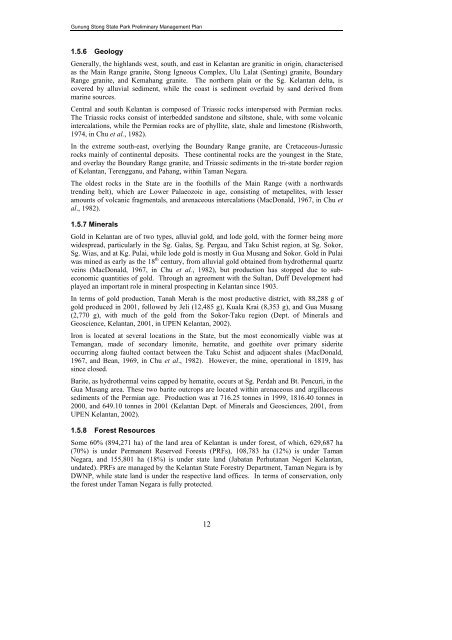FINAL VERSION FOR APPROVAL - Sdn Bhd - WWF Malaysia
FINAL VERSION FOR APPROVAL - Sdn Bhd - WWF Malaysia
FINAL VERSION FOR APPROVAL - Sdn Bhd - WWF Malaysia
Create successful ePaper yourself
Turn your PDF publications into a flip-book with our unique Google optimized e-Paper software.
Gunung Stong State Park Preliminary Management Plan<br />
1.5.6 Geology<br />
Generally, the highlands west, south, and east in Kelantan are granitic in origin, characterised<br />
as the Main Range granite, Stong Igneous Complex, Ulu Lalat (Senting) granite, Boundary<br />
Range granite, and Kemahang granite. The northern plain or the Sg. Kelantan delta, is<br />
covered by alluvial sediment, while the coast is sediment overlaid by sand derived from<br />
marine sources.<br />
Central and south Kelantan is composed of Triassic rocks interspersed with Permian rocks.<br />
The Triassic rocks consist of interbedded sandstone and siltstone, shale, with some volcanic<br />
intercalations, while the Permian rocks are of phyllite, slate, shale and limestone (Rishworth,<br />
1974, in Chu et al., 1982).<br />
In the extreme south-east, overlying the Boundary Range granite, are Cretaceous-Jurassic<br />
rocks mainly of continental deposits. These continental rocks are the youngest in the State,<br />
and overlay the Boundary Range granite, and Triassic sediments in the tri-state border region<br />
of Kelantan, Terengganu, and Pahang, within Taman Negara.<br />
The oldest rocks in the State are in the foothills of the Main Range (with a northwards<br />
trending belt), which are Lower Palaeozoic in age, consisting of metapelites, with lesser<br />
amounts of volcanic fragmentals, and arenaceous intercalations (MacDonald, 1967, in Chu et<br />
al., 1982).<br />
1.5.7 Minerals<br />
Gold in Kelantan are of two types, alluvial gold, and lode gold, with the former being more<br />
widespread, particularly in the Sg. Galas, Sg. Pergau, and Taku Schist region, at Sg. Sokor,<br />
Sg. Wias, and at Kg. Pulai, while lode gold is mostly in Gua Musang and Sokor. Gold in Pulai<br />
was mined as early as the 18 th century, from alluvial gold obtained from hydrothermal quartz<br />
veins (MacDonald, 1967, in Chu et al., 1982), but production has stopped due to subeconomic<br />
quantities of gold. Through an agreement with the Sultan, Duff Development had<br />
played an important role in mineral prospecting in Kelantan since 1903.<br />
In terms of gold production, Tanah Merah is the most productive district, with 88,288 g of<br />
gold produced in 2001, followed by Jeli (12,485 g), Kuala Krai (8,353 g), and Gua Musang<br />
(2,770 g), with much of the gold from the Sokor-Taku region (Dept. of Minerals and<br />
Geoscience, Kelantan, 2001, in UPEN Kelantan, 2002).<br />
Iron is located at several locations in the State, but the most economically viable was at<br />
Temangan, made of secondary limonite, hematite, and goethite over primary siderite<br />
occurring along faulted contact between the Taku Schist and adjacent shales (MacDonald,<br />
1967, and Bean, 1969, in Chu et al., 1982). However, the mine, operational in 1819, has<br />
since closed.<br />
Barite, as hydrothermal veins capped by hematite, occurs at Sg. Perdah and Bt. Pencuri, in the<br />
Gua Musang area. These two barite outcrops are located within arenaceous and argillaceous<br />
sediments of the Permian age. Production was at 716.25 tonnes in 1999, 1816.40 tonnes in<br />
2000, and 649.10 tonnes in 2001 (Kelantan Dept. of Minerals and Geosciences, 2001, from<br />
UPEN Kelantan, 2002).<br />
1.5.8 Forest Resources<br />
Some 60% (894,271 ha) of the land area of Kelantan is under forest, of which, 629,687 ha<br />
(70%) is under Permanent Reserved Forests (PRFs), 108,783 ha (12%) is under Taman<br />
Negara, and 155,801 ha (18%) is under state land (Jabatan Perhutanan Negeri Kelantan,<br />
undated). PRFs are managed by the Kelantan State Forestry Department, Taman Negara is by<br />
DWNP, while state land is under the respective land offices. In terms of conservation, only<br />
the forest under Taman Negara is fully protected.<br />
12
















